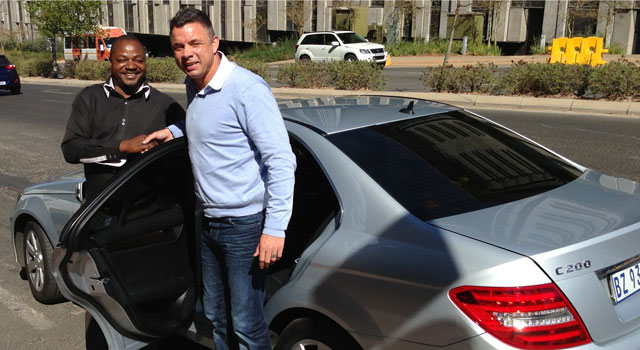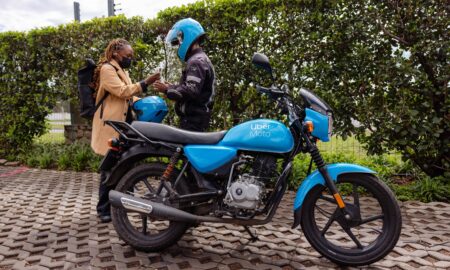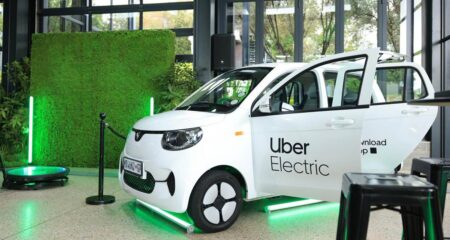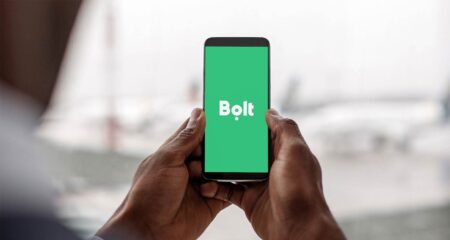
It’s been three minutes since I booked a taxi ride on my smartphone; not quite enough time to get to the road outside my office in Rosebank. My taxi driver has already arrived and is calling to let me know.
I find a white Mercedes C-Class pulled up at the kerb. There is no taxi sign on the car, but I recognise it immediately: the app that I used to book the ride gave me a description of the car and a photo of the driver. A tall, slim man wearing a white-collared shirt and brown leather jacket offers me a generous toothy smile. I already know his name is Wonderful and he has a “user” rating of 4,5 stars.
“Would you like the air conditioner on?” he asks after introducing himself. And then: “Would you like me to turn on the radio?”
Wonderful Ndou, 43, is a driving “associate” of Uber, the company that allowed me to book my taxi ride and pay for it. But Uber is not a taxi company. It’s a firm that “seamlessly connects riders to drivers” through its smartphone applications.
The strategy has allowed Uber to expand at an incredible rate — since its founding in 2009, it now operates in more than 70 cities across the globe – with minimal administrative requirements and a fraction of the overhead costs of a regular taxi company. In some countries, it is capitalising on legal loopholes, provoking the wrath of its more established rivals.
According to the Guardian, it is facing or has faced bans, restrictions, court cases or protests in Brussels, Paris, Berlin, Houston, Portland, New Orleans, Seattle, Miami, New York, San Francisco, Chicago, Washington, DC, Vancouver and Toronto. Opponents argue it’s a taxi company in all but name, and that it unfairly gets around the licence fees traditional taxi companies are obliged to pay.
“Uber is a software technology company,” the GM of Uber in Cape Town, Anthony Le Roux, told the Mail & Guardian. “We’re not in the business of administering taxis.”
Uber guarantees a high-end private driver experience by “partnering” with drivers who take on their own business risk. Uber drivers must provide their own vehicle — in South Africa you can expect a Mercedes C-Class, a BMW 3-Series or an Audi A4 — have a professional driver’s permit, and partners pay for their own passenger liability insurance.
Travellers need a smartphone and a credit card to use the service, which uses the phone’s GPS to establish your whereabouts, flags the Uber cars in your area and tells you how long each will take to get to you. On requesting a ride, the app gives an estimate of the trip’s cost.
When the ride is complete, Uber debits your account and e-mails you an invoice, with a map of the route and how long it took. No physical cash is exchanged. You can then rate your driver; something to which Uber attributes its “predictably high” service standards. “With Uber, the rider can count on having a consistently safe and pleasant experience,” says Le Roux.
Ndou says he likes this feedback. “For me, it’s all about service,” he says. He joined Uber seven months ago, soon after its August launch in the country. He had previously worked for a high-end shuttle company, mainly transporting VIPs. Ndou’s car was owned, serviced and insured by the company. In exchange he paid monthly “dues” — a set fee — and then kept the money he made.
Uber offers a completely different business model. In addition to providing, servicing and licensing his own car, Ndou had to pay R900 for the TomTom GPS mounted on his windscreen that allows him to interact with Uber. For work, he uses an iPhone provided by the company.
Every Wednesday, Uber pays him for the week’s trips and takes a 20% cut from his fees.
Ndou says he makes less money with Uber than with his previous company. He attributes this to lower fees. Uber charges R295 for a trip to OR Tambo airport, whereas other taxis and shuttles can charge up to R550.
In Cape Town, Le Roux says, the prices are actually 20% to 30% higher than average, but in Johannesburg, prices come “at or even cheaper than normal metered rates”.
Uber charges its minimum R50 fee for the 1,5km trip we take. Because I spend another 40 minutes talking to the driver, the final cost comes to R82.
It’s a short walk to the nearest taxi rank. I hop into a metered taxi to get back to the office. The driver asks for his name to be kept out of the newspaper. Like Ndou, he owns his own car — an aged red Toyota with poor ventilation.
The “local” trip costs R70. The driver says he will not charge me extra if I keep him waiting, or chatting, for an extra 10 or 15 minutes. He doesn’t have adequate change for the R100 I produce to pay, eventually getting R80 instead of R70 and complaining when I ask for a receipt.
He works a 15-hour shift on average, starting at 6am and ending at around 9pm. Ndou also works very long hours, but manages his own time and does not have to be based at a rank. Over weekends, he can go for more than 20 hours straight.
Ndou places himself in strategically busy areas, because Uber dispatches the driver situated closest to the trip request.
Ndou is not allowed to turn down a trip he’s been assigned.
The company accepts any drivers who meet the stipulated requirements, which includes having a professional driver’s permit. This is regardless of whether they are already contracted to a taxi company.
The chair of the Johannesburg regional metered taxi council, Motjhane Mabote, says some local drivers were concerned the company “was here to take our jobs away”.
But because in South Africa Uber partners with existing taxis, Mabote says: “I personally don’t think it’s a problem. You could be working for one company and supplement your income working for Uber. You don’t have to pay fees to be involved. You do your job and you get paid for it.” — (c) 2014 Mail & Guardian
- Visit the Mail & Guardian Online, the smart news source




